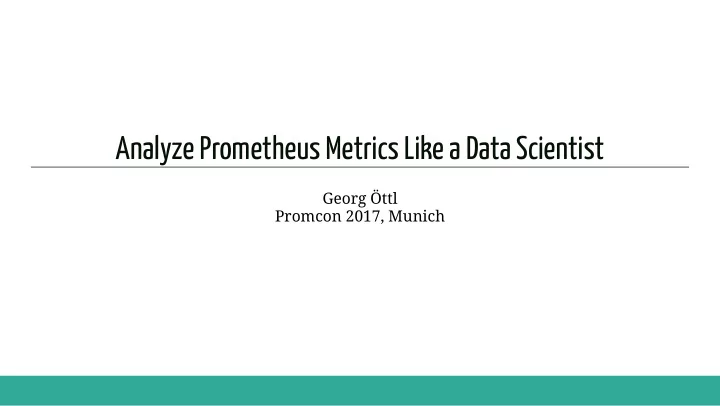

Analyze Prometheus Metrics Like a Data Scientist Georg Öttl Promcon 2017, Munich
About me / experiences ● Enterprise Software Dev. ● Data Science Services ● Dev / DevOps / Ops ● Developer who likes Math Twitter: @goettl
Objective talk Pushing the limits of prometheus: can I have a more reliable alerts model with insights from datasience? ● Journey on how to improve alerts / dashboards with insights from datasience ● Integration points to open source datasience tools ● Bring light into the dark (like prometheus did)
... should I? Don't use deep learning and datasience when a straight- forward 15 minute rule-based system does well. Datascience can help you to detect patterns and facts in your metrics you can't see.
What is already available. When do I start? ● Great architecture to get high quality data ● Numerical data ● Apply mathematical functions on it ● Easy and fast navigable (promql) ● Alert / rule model ● Chart / histogram vis with Grafana
Next step: get data out of prometheus ... to be used in Open Source datascience tools
What data to export? ● Raw metrics data, no functions applied on it ● As much as possible ● Without putting too much load on prometheus / running into a timeout
Two ways to get data out of prometheus ● HTTP API (Poll) ● Exploratory data analysis ● REMOTE API (Push) ● Streaming analysis
HTTP API - /api/v1/query_range requests.get( url = 'http://127.0.0.1:9090/api/v1/query_range', params = { 'query': 'sum({__name__=~".+"}) by (__name__,instance)', 'start': '1502809554', 'end' : '1502839554', 'step' : '1m' }) {"data": {..., "resultType": "matrix", "result": [{ "metric": {"method": "GET",...}, "values": [[1500008340,"3"], ... ]},...] }}
Target format for datascience tools (tabular, csv) X id time value req_dur ... A 1 1 4 ... A 2 2 5 ... B 1 2 3 ... B 2 3 2 ... y id time value A 1 1 A 2 1 B 1 0 B 2 0 ... ... ...
Easyiest way to export ● Grafana ● Python (robustperception blog entry)
Reduce data: use domain knowledge to select relevant data subset {__name__=~".+"}
Tip: Use alerts as initial set of training labels y = ALERTS{name="high_latency"} tidy up, verify true positives, annotate manually, ...
Normalize prometheus datatypes ● Gauges, histograms are ok ● Counters have to be processed ● No repetition in counters. No statistical value in that. ● Use e.g derivative function to convert a counter to a gauge equivalent
Examples Applied datasience on prometheus metrics
Example 1 I can predict the latency of http requests ● Can I use the prometheus function predict_linear? ● Are there other predictions possible? ↡↡ R Notebook predict_linear ↡↡
Example 2 There are a better suited metrics to predict http5x failures than the one I use
Choose method
Get metrics into the right format for method ● Training data with labels needed (X,y) ● Seasonally adjust
Apply feature selection algorithm from sklearn.feature_selection import RFE from sklearn.ensemble import RandomForestRegressor ... # perform feature selection rfe = RFE( RandomForestRegressor( n_estimators=500, random_state=1, min_samples_split=5 ), 1) fit = rfe.fit(X, y) ... Selected Feature: POST
Feedback cycle Rewrite your alerts and dashboards to use label POST to better predict http 5x errors
Example 3 - metrics / feature selection with library tsfresh ● Metrics selection / ranking similar to example 1 ● Metrics extension by applying functions to metrics https://github.com/blue-yonder/tsfresh
Prometheus datascience mantra ● Create hypothesis about your system and metrics ● Get metrics (devops) and convert them into the right format ● Use statistical methods to verify hypothesis ● Feedback results to system, the dashboards and alerts
Lessons learned ● Alert model improves with insights from descriptive statistics and ML! ● Depending on the result, correct, discard or handle data differently ● Day to day usecase: e.g. reduced try and error config on predict_linear function ● No need to process metrics streaming with ML/AI yet
Thx for having me here at promcon.io 2017! Questions? Georg Öttl Twitter Handle: @goettl
Recommend
More recommend